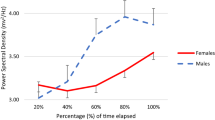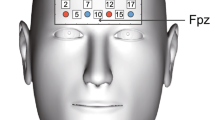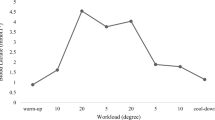Abstract
Purpose
The purpose of this study was to measure the EEG response in the prefrontal cortex (PFC) and motor cortex (MC) during incremental exercise and align these responses with ventilatory parameters.
Methods
The EEG activity at the motor (MC) and frontal cortices was measured during an incremental exercise test (IET) in 11 cyclists (peak oxygen uptake \(\left( {\dot{V}{\text{O}}_{{2 {\text{peak}}}} } \right)\) 4.1 ± 0.74 (SD) L min−1). EEG power spectral densities were calculated for alpha slow (αS) (8–10 Hz), alpha fast, (αF) (10–13 Hz), Beta (β) (13–30 Hz), and Gamma (γ) (30–40 Hz). EEG data were calculated as % change from eyes open (EO) baseline and a repeated measures analysis of variance (ANOVA) was performed on regions of interest (ROI), time and bandwidth.
Results
All EEG activity increased from 50 % \(\dot{V}{\text{O}}_{{ 2 {\text{peak}}}}\) to ventilatory threshold (VT) (P = 0.045) and respiratory compensation point (RCP) (P = 0.019) and decreased from RCP to end of exercise (END) (P = 0.04). Significant differences between regions were found at the VLPFC and MC for both αS and αF. αS and αF increased from 50 % \(\dot{V}{\text{O}}_{{ 2 {\text{peak}}}}\) to RCP (14.9 ± 10.2 to 23.8 ± 15.5 and 18.9 ± 10.6 to 26.12 ± 12.7, respectively) and then decreased to END (23.8 ± 15.5 to 14.4 ± 10.3 and 26.1 ± 12.7, to 17.7 ± 8.8, respectively) (P < 0.01) and concomitantly only decreased significantly in MC in αF from VT to END (P < 0.05).
Conclusion
There is a decline in the EEG response to exercise in the PFC following the RCP, whilst alpha activity in the MC is preferentially maintained; therefore, changes within the PFC appear to play a role in exercise termination.




Similar content being viewed by others
Abbreviations
- PaCO2 :
-
Arterial carbon dioxide tension
- \(\dot{V}{\text{O}}_{{ 2 {\text{peak}}}}\) :
-
Peak oxygen consumption
- \(\dot{V}{\text{E}}/\dot{V}{\text{O}}_{2}\) :
-
Ventilatory equivalent for oxygen
- \(\dot{V}{\text{E}}/\dot{V}{\text{CO}}_{2}\) :
-
Ventilatory equivalent for carbon dioxide
- ACC:
-
Anterior cingulate cortex
- ANOVA:
-
Analysis of variance
- AntPFC:
-
Anterior prefrontal cortex
- COxy:
-
Cerebral oxygenation
- DLPFC:
-
Dorsolateral prefrontal cortex
- EEG:
-
Electroencephalography
- IET:
-
Incremental exercise test
- MC:
-
Motor cortex
- MCAv:
-
Middle cerebral artery velocity
- MRCP:
-
Movement-related cortical potentials
- NIRS:
-
Near infra-red spectroscopy
- PFC:
-
Prefrontal cortex
- RCP:
-
Respiratory compensation point
- ROI:
-
Region of interest
- sLORETA:
-
Standardised low-resolution brain electromagnetic tomography
- VLPFC:
-
Ventrolateral prefrontal cortex
- VT:
-
Ventilatory threshold
References
Adrian E (1948) The physical background of perception. Arch Neurol Psychiatry 59:441–442. doi:10.1001/archneurpsyc.1948.02300380170019
Amann M, Subudhi AW, Foster C (2006) Predictive validity of ventilatory and lactate thresholds for cycling time trial performance. Scand J Med Sci Sports 16:27–34. doi:10.1111/j.1600-0838.2004.00424.x
Aron AR, Robbins TW, Poldrack RA (2004) Inhibition and the right inferior frontal cortex. Trends Cogn Sci 8:170–177. doi:10.1016/j.tics.2004.02.010
Bailey SP, Hall EE, Folger SE, Miller PC (2008) Changes in EEG during graded exercise on a recumbent cycle ergometer. J Sports Sci Med 7:505–511
Başar E, Schürmann M, Başar-Eroglu C, Karakaş S (1997) Alpha oscillations in brain functioning: an integrative theory. Int J Psychophysiol 26:5–29. doi:10.1016/S0167-8760(97)00753-8
Bhambhani Y, Malik R, Mookerjee S (2007) Cerebral oxygenation declines at exercise intensities above the respiratory compensation threshold. Respir Physiol Neurobiol 156:196–202. doi:10.1016/j.resp.2006.08.009
Brodmann K (2006) Localisation in the cerebral cortex: the principles of comparative localisation in the cerebral cortex based on cytoarchitectonics, 3rd edn. Springer, US. doi:10.1007/b138298
Brummer V, Schneider S, Struder HK, Askew CD (2011) Primary motor cortex activity is elevated with incremental exercise intensity. Neuroscience 181:150–162. doi:10.1016/j.neuroscience.2011.02.006
Caiozzo VJ, Davis JM, Ellis JF, Azus JL, Vandagriff R, Prietto CA, McMaster WC (1982) A comparison of gas exchange indices used to detect the anaerobic threshold. J Appl Physiol 53:1184–1189
Craig AD (2000) Thermosensory activation of insular cortex. Nat Neurosci 3:184–190
Craig AD (2002) How do you feel? Interoception: the sense of the physiological condition of the body. Nat Rev Neurosci 3:655–666
Davis JA (1985) Anaerobic Threshold: review of the concept and directions for future research. Med Sci Sports Exerc 17:6–18
De Cesarei A, Codispoti M (2011) Affective modulation of the LPP and α-ERD during picture viewing. Psychophysiology 48:1397–1404. doi:10.1111/j.1469-8986.2011.01204.x
Ekkekakis P, Acevedo EO (2006) Affective reponses to acute exercise: toward a psychobiological dose-response model. In: Ekkekakis P, Acevedo EO (eds) Psychobiology of physical activity. Human Kinetics, Champaign, Illinois, pp 91–109
Evarts EV (1980) Brain mechanisms in voluntary movement. In: Dennis M (ed) Neural mechanisms in behaviour. Springer, New York, pp 223–259
Fumoto M et al (2010) Ventral prefrontal cortex and serotonergic system activation during pedaling exercise induces negative mood improvement and increased alpha band in EEG. Behav Brain Res 213:1–9. doi:10.1016/j.bbr.2010.04.017
Gandevia SC, Allen GM, Butler JE, Taylor J (1996) Supraspinal factors in human muscle fatigue: evidence for suboptimal output from the motor cortex. J Physiol 490:529–536
Gonzalez-Alonso J, Dalsgaard MK, Osada T, Volianitis S, Dawson EA, Yoshiga CC, Secher NH (2004) Brain and central haemodynamics and oxygenation during maximal exercise in humans. J Physiol 557:331–342. doi:10.1113/jphysiol.2004.060574
Goodall S, Gonzalez-Alonso J, Ali L, Ross EZ, Romer LM (2012) Supraspinal fatigue after normoxic and hypoxic exercise in humans. J Physiol 590:2767–2782. doi:10.1113/jphysiol.2012.228890
Haber SN, Knutson B (2010) The reward circuit: linking primate anatomy and human imaging. Neuropyschopharmacology 35:4–26
Hampshire A, Chamberlain SR, Monti MM, Duncan J, Owen AM (2010) The role of the right inferior frontal gyrus: inhibition and attentional control. Neuroimage 50:1313–1319. doi:10.1016/j.neuroimage.2009.12.109
Harris JB (2005) Differential conditioning of alpha amplitude: a fresh look at an old phenomenon. Clin Neurophysiol 116:1433–1443. doi:10.1016/j.clinph.2005.02.003
Hilty L, Jäncke L, Luechinger R, Boutellier U, Lutz K (2010) Limitation of physical performance in a muscle fatiguing handgrip exercise is mediated by thalamo-insular activity. Hum Brain Mapp 32:2151–2160. doi:10.1002/hbm.21177
Hilty L, Langer N, Pascual-Marqui R, Boutellier U, Lutz K (2011) Fatigue-induced increase in intracortical communication between mid/anterior insular and motor cortex during cycling exercise. Eur J Neurosci 34:2035–2042. doi:10.1111/j.1460-9568.2011.07909.x
Jiang C, Haddad G (1994) Oxygen deprivation inhibits a K+ channel independently of cytosolic factors in rat central neurons. J Physiol 481:15–26
Jorgensen LG, Perko G, Secher NH (1992) Regional cerebral artery mean flow velocity and blood flow during dynamic exercise in humans. J Appl Physiol 73:1825–1830
Kayser B, Narici M, Binzoni T, Grassi B, Cerretelli P (1994) Fatigue and exhaustion in chronic hypobaric hypoxia: influence of exercising muscle mass. J Appl Physiol 76:634–640
Klimesch W, Doppelmayr M, Russegger H, Pachinger T, Schwaiger J (1998) Induced alpha band power changes in the human EEG and attention. Neurosci Lett 244:73–76. doi:10.1016/S0304-3940(98)00122-0
Leung HC, Cai W (2007) Common and differential ventrolateral prefrontal activity during inhibition of hand and eye movements. J Neurosci 27:9893–9900. doi:10.1523/JNEUROSCI.2837-07.2007
Levy BJ, Wagner AD (2011) Cognitive control and right ventrolateral prefrontal cortex: reflexive reorienting, motor inhibition, and action updating. Ann N Y Acad Sci 1224:40–62. doi:10.1111/j.1749-6632.2011.05958.x
Linkis P, Jorgensen LG, Olesen HL, Madsen PL, Lassen NA, Secher NH (1995) Dynamic exercise enhances regional cerebral artery mean flow velocity. J Appl Physiol 78:12–16
Logan GD, Cowan WB (1984) On the ability to inhibit thought and action: a theory of an act of control. Psychol Rev 91:295–327
Miller PC (2000) The prefrontal cortex and cognitive control. Nat Rev Neurosci 1:59–65
Miller E, Cohen JD (2001) An integrative theory of prefrontal cortex function. Ann Rev Neurosci 24:167–202
Nielsen HB, Boushel R, Madsen P, Secher NH (1999) Cerebral desaturation during exercise reversed by O2 supplementation. Am J Physiol Heart Circ Physiol 277:H1045–H1052
Nielsen B, Hyldig T, Bidstrup F, Gonzalez-Alonso J, Christoffersen GRJ (2001) Brain activity and fatigue during prolonged exercise in the heat Pflugers Archiv European. J Physiol 442:41–48. doi:10.1007/s004240100515
Noakes T, Peltonen J, Rusko H (2001) Evidence that a Central Governor regulates exercise performance during acute hypoxia and hyperoxia. J Exp Biol 204:3225–3234
Petruzello SJ, Landers DM (1994) State anxiety reduction and exercise. Med Sci Sports Exerc 26:1028–1035
Petsche H, Kaplan S, von Stein A, Filz O (1997) The possible meaning of the upper and lower alpha frequency ranges for cognitive and creative tasks. Int J Psychophysiol 26:77–97. doi:10.1016/S0167-8760(97)00757-5
Pfurtscheller G, da Silva FHL (1999) Event-related EEG/MEG synchronization and desynchronization: basic principles. Clin Neurophysiol 110:1842–1857
Racinais S, Buchheit M, Girard O (2014) Breakpoints in ventilation, cerebral and muscle oxygenation, and muscle activity during an incremental cycling exercise. Front Physiol 5:142 doi:10.3389/fphys.2014.00142
Rasmussen P, Stie H, Nybo L, Nielsen B (2004) Heat induced fatigue and changes of the EEG is not related to reduced perfusion of the brain during prolonged exercise in humans. J Therm Biol 29:731–737. doi:10.1016/j.jtherbio.2004.08.047
Rasmussen P, Nielsen J, Overgaard M, Krogh-Madsen R, Gjedde A, Secher NH, Petersen NC (2010) Reduced muscle activation during exercise related to brain oxygenation and metabolism in humans. J Physiol 588:1985–1995. doi:10.1113/jphysiol.2009.186767
Rauch L, Schonbachler G, Noakes T (2013) Neural correlates of motor vigour and motor urgency during exercise. Sports Med 43:227–241. doi:10.1007/s40279-013-0025-1
Ridderinkhof KR, van den Wildenberg WPM, Segalowitz SJ, Carter CS (2004) Neurocognitive mechanisms of cognitive control: the role of prefrontal cortex in action selection, response inhibition, performance monitoring, and reward-based learning. Brain Cogn 56:129–140. doi:10.1016/j.bandc.2004.09.016
Robergs RA (2014) A critical review of the history of low- to moderate-intensity steady-state VO2 kinetics. Sports Med 44:641–653. doi:10.1007/s40279-014-0161-2
Robergs RA, Dwyer D, Astorino TA (2010) Recommendations for improved data processing from expired gas analysis indirect calorimetry. Sports Med 40:95–111
Rupp T, Perrey S (2008) Prefrontal cortex oxygenation and neuromuscular responses to exhaustive exercise. Eur J Appl Physiol 102:153–163. doi:10.1007/s00421-007-0568-7
Santos-Concejero J, Billaut F, Grobler L, Olivan J, Noakes TD, Tucker R (2015) Maintained cerebral oxygenation during maximal self-paced exercise in Kenyan runners. J Appl Physiol 118:156–162. doi:10.1152/japplphysiol.00909.2014
Schneider S et al (2009) EEG activity and mood in health orientated runners after different exercise intensities. Physiol Behav 96:709–716. doi:10.1016/j.physbeh.2009.01.007
Subudhi AW, Lorenz MC, Fulco CS, Roach RC (2008) Cerebrovascular responses to incremental exercise during hypobaric hypoxia: effect of oxygenation on maximal performance. Am J Physiol Heart Circ Physiol 294:H164–H171. doi:10.1152/ajpheart.01104.2007
Subudhi AW, Miramon BR, Granger ME, Roach RC (2009) Frontal and motor cortex oxygenation during maximal exercise in normoxia and hypoxia. J Appl Physiol 106:1153–1158. doi:10.1152/japplphysiol.91475.2008
Suda M, Fukuda M, Sato T, Iwata S, Song M, Kameyama M, Mikuni M (2009) Subjective feeling of psychological fatigue is related to decreased reactivity in ventrolateral prefrontal cortex. Brain Res 1252:152–160. doi:10.1016/j.brainres.2008.11.077
Thompson T, Steffert T, Ros T, Leach J, Gruzelier J (2008) EEG applications for sport and performance. Methods 45:279–288. doi:10.1016/j.ymeth.2008.07.006
Uusberg A, Uibo H, Kreegipuu K, Allik J (2013) EEG alpha and cortical inhibition in affective attention. Int J Psychophysiol 89:26–36. doi:10.1016/j.ijpsycho.2013.04.020
von Stein A, Sarnthein J (2000) Different frequencies for different scales of cortical integration: from local gamma to long range alpha/theta synchronization. Int J Psychophysiol 38:301–313
Yanagisawa H, Dan I, Tsuzuki D, Kato M, Okamoto M, Kyutoku Y, Soya H (2010) Acute moderate exercise elicits increased dorsolateral prefrontal activation and improves cognitive performance with Stroop test. Neuroimage 50:1702–1710. doi:10.1016/j.neuroimage.2009.12.023
Acknowledgments
We wish to thank Professor Rob Robergs for his contribution in the development of the \(\dot{V}{\text{O}}_{2}\) system, lab view programming and advice.
Conflict of interest
The authors declare they have no conflict of interest.
Author information
Authors and Affiliations
Corresponding author
Additional information
Communicated by Toshio Moritani.
Rights and permissions
About this article
Cite this article
Robertson, C.V., Marino, F.E. Prefrontal and motor cortex EEG responses and their relationship to ventilatory thresholds during exhaustive incremental exercise. Eur J Appl Physiol 115, 1939–1948 (2015). https://doi.org/10.1007/s00421-015-3177-x
Received:
Accepted:
Published:
Issue Date:
DOI: https://doi.org/10.1007/s00421-015-3177-x




